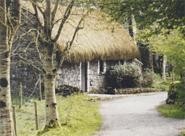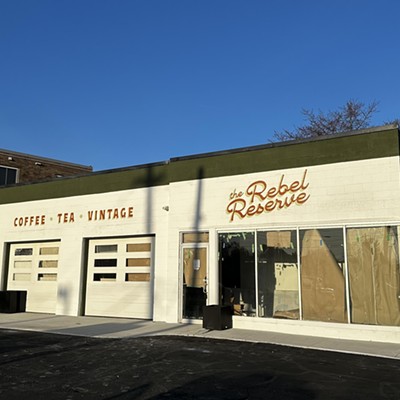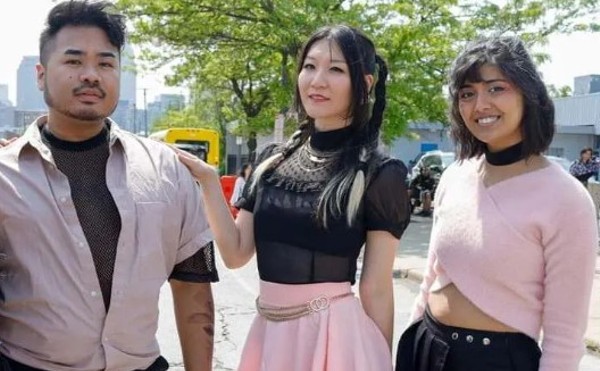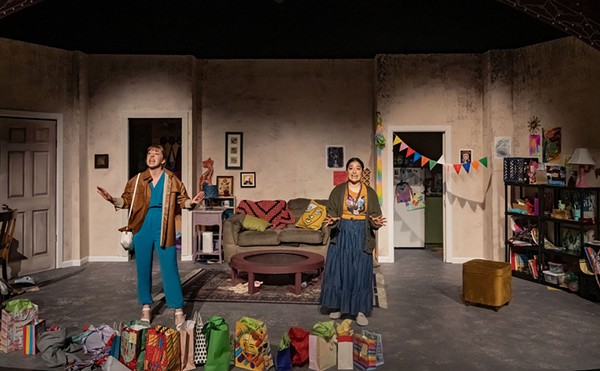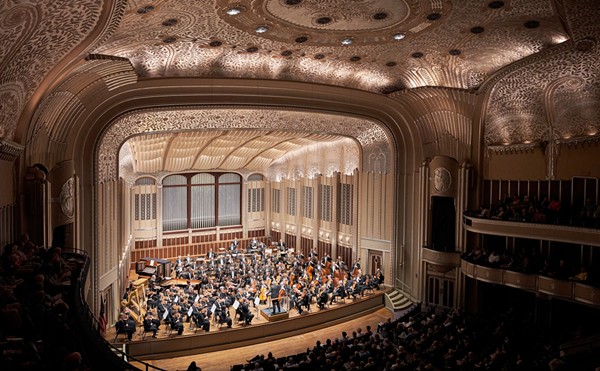Ireland Collection -- Youngstown photographer Dagmar Amrhein recently toured Cork and Dublin with her shutter in landscape mode. What she captured are lovely images of thatched houses, quaint storefronts, and historic castles and churches, with paths winding into the distance. Among the highlights is a wooden door set in a stone wall overgrown with dead ivy. The scene, shot at Cork University, looks almost too ancient and pastoral to be real, as if it were an illustration of the Shire, home of Tolkien's hobbits; an air of mystery hangs over it, as if something significant had just taken place or were about to occur. Also alluring is a row of multicolored houses lining a road that descends into a gorgeous bay; the sloping path in the foreground forms a fetching triangle against the straight edge of the water in the back, while the dwellings themselves line up like a gingerbread village out of a fairy tale. Amrhein is, unquestionably, a pro; one wishes her work were more substantial. As it is, there's not much here you couldn't find in a well-made calendar of Ireland. Through April 8 at Studio of Five Rings, 2400 Superior Ave., Suite 201, 216-771-0830, www.studioof5rings.com. -- Zachary Lewis
On a Pedestal -- Half of this 19-piece sculpture exhibition, juried by Cleveland art legend Viktor Schreckengost, is figural and fairly straightforward. But it's the show's abstract half that's most notable -- particularly Barbara Stanczak's "Embracing Light," a bowl-like object carved of snow-white alabaster with a plateau in the middle. Though simple formally, the work is conceptually and sensuously complex: Smooth on the outside and shaped like lips closing around a grainy, rough-tipped tongue, it exemplifies an embrace with complete, organic elegance. What's more, its unusual contours and translucent surface disperse light in myriad directions: Exposed sections bask in or "embrace" the light, while others lie tucked away in shadow. Elsewhere, Margot Gotoff's "Poetry" combines figural and abstract elements in an expressive whole. It's made up of a translucent blown-glass torso lined internally with a wide vein of brilliant blue; attached at the hip is a small figure of Nike, the Greek goddess of triumph. It's a moving portrayal of art as something deeply personal and all-consuming. In marked contrast to the precious alabaster and meticulously blown glass, there are the wooden scraps and spare parts employed by David Brunner in "Metropolis." Jagged, rounded, and flat-topped pieces, all painted white, suggest skyscrapers and other buildings nestled in a strangely realistic city block that rises mere inches. Pieces of wood and some paint: Five bucks. Brunner's imagination: priceless. Through April 14 at the Sculpture Center, 1834 East 123rd St., 216-229-6527, www.sculpturecenter.org. -- Lewis
ONGOING
All Digital -- Still lobbying for separation of art and computers? This exhibit will counter your most defiant belief in the primacy of traditional media. Just try to experience John Simon's work without wonder, let alone brush past it quickly. His "Endless Victory" has all the color of a Mondrian painting, though it consists only of a rimless laptop screen, its surface constantly in motion with tiny dots moving antlike along ever-shifting paths. The most elaborate of Simon's many entries, "Victory" is also the only one that appears to spin on multiple axes; painters have executed some fancy tricks over the centuries, but nothing like this. In Leo Villareal's "Instances," three black screens covered in tiny white lights display a sequence that looks and even sounds like fireworks; it may not be the grandest technological achievement here, but it's magical nonetheless. Still not convinced? Walk into the room where Charles Sandison has set up cameras displaying the complete text of the 1911 Encyclopedia Britannica. Typewritten words skitter randomly over dark walls, forming meaningless phrases that exist for only a few seconds. Imagine refrigerator-magnet poetry, only many times larger and operated by some divine, invisible force you experience physically rather than just visually. Through May 7 at the Museum of Contemporary Art, 8501 Carnegie Ave., 216-421-8671, www.mocacleveland.org. -- Lewis
Curve Series: Jon Pylypchuk -- To call this show disappointing is to compliment it backhandedly, for disappointed is precisely how Canadian-born Jon Pylypchuk wants viewers to feel upon encountering his bitterly satirical take on life. The title of this one-room installation suggests anger instantly: "You Asked Me to Come See Your Routine -- You Call This a Fucking Routine?" But it takes some time to deduce the object of that anger. Scattered around the circular gallery are six tree-like objects crudely fashioned of dark wood, their branches angular and leafless. Standing near these are six short, low-tech, humanoid figurines, also made of wood, but with velvety brown hair and snowmanlike eyes and noses. All are wearing baggy denim pants around their ankles, looking dejected or oblivious, in the fashion of today's hip-hoppers. Some appear to be hugging or humping the trees. All in all, it's a sad, barren landscape, populated by lonely, undignified, animalistic creatures clinging to anything that offers protection or comfort, or makes them feel good. As a portrayal of humanity on earth, it's both frightening and disturbing, and it holds out only two options: suicide or utter depravity. But as effective as "Routine" is at conveying these notions, many viewers are likely to turn away from Pylypchuk's bleak philosophy. Through May 7 at the Museum of Contemporary Art, 8501 Carnegie Ave., 216-421-8671, www.mocacleveland.org. -- Lewis
Dioramafantasauramania -- The dioramas created by the three artists in this quirky, bountifully creative show are a far cry from grade school. Christopher Duffy's miniaturist masterpiece "If It Happens, I'd Be Pretty Okay With It as Long as I Got to See It" depicts a cyclone destroying a Wal-Mart -- reproduced entirely with construction paper. Tiny household devices sit frozen in midair amid the paper twister; dead-on vacuum cleaners, lawn mowers, microwaves, and stereos vie for attention with dozens of other such objects in a sculpture of dazzling intricacy. Thu Tran, meanwhile, expertly employs childlike whimsy in her fabric projects. Unlike Duffy, she eschews narrative to operate in pure Dada mode: A pillow gone wild, her "Exxxtreme Animal Island" is a plush, pointy, three-dimensional landscape suspended from the ceiling by wires and densely populated with dangerous creatures, each fashioned from a different material and stuffed with cotton; a child would be drawn to its cuddliness before running away in fright. The talents of Suzie Ririe are the most diffuse of this trio. Meagerly representing her here are a set of fancy dark wine goblets encrusted with fake diamonds spelling out politically incorrect labels ("hick," "white trash") and a beaker of red, yellow, and blue pills recalling the videogame Dr. Mario. Through March at Front Room Gallery, 7209 St. Clair Ave. #302, www.frontroomcleveland.com. -- Lewis
Drawn, Exposed, and Impressed -- The first in a series of shows presented by the art museum at the Museum of Contemporary Art, this small collection of recent works on paper covers vast aesthetic territory efficiently and attractively. Among the drawings is an unforgettable charcoal view of Cleveland's lakeshore by Laurence Channing, as well as Chuck Close's portrait of a young, wild-haired Philip Glass (titled "Phil Spitbite"), composed of Close's trademark tiny squares and shaded circles. Tops in the "exposed" category are Spencer Tunick's "Ohio 4," photographic evidence that hundreds of Clevelanders really did get naked outdoors one chilly morning in 2004, and Bert Teunissen's "Nuit St. Georges #8," an inkjet photo of a woman posed in an elegant sitting room, which rivals the subtlety of any Dutch master's still life. Printmaker Neil Welliver spared no pain to create "Stump," a multicolored woodcut print crawling with moss, ferns, and shoots. By contrast, black and white are all Richard Serra needs in "IV Hreppholar" (a city in Iceland), an etching made with a thickly scarred slab of basalt. The piece resembles a dried patch of tar, and you may find yourself entranced by the beating it's seemingly endured. Through May 7 at the Museum of Contemporary Art, 8501 Carnegie Ave., 216-421-7340, www.clevelandart.org. -- Lewis
Life Studies -- Instead of mere paper, Hudson artist Peggy Kwong-Gordon creates her cohesive, spiritually grounded drawings on manila fiber, vellum, and pressed wool -- natural and intrinsically beautiful substances that symbolize her Chinese heritage and Taoist philosophy. By way of subject, take your pick as to what's the most honest. Maybe it's the self-portrait, in which pencil-drawn Chinese characters outline the central figure against a backdrop of English text; what better way to represent the Chinese American soul? Then there are the "Visual Glossary" pictures: large, single-frame images of Chinese characters on wool paper that just happen to look like the concepts they represent (the word "Tao," for example, is defined as a "gateway" and resembles an open door). But not everything operates on such a high intellectual level. Youthful joy oozes from a long set of loose, improvisational gouache drawings called "Writing Happiness." Each is a composition in perfect, weightless balance: a single squiggly white line (perhaps an unraveled Chinese character) against a primary-color background. With "Shards," though, Kwong-Gordon points most profoundly to her union of text and soul. She makes a paper mold of her own body, draws Chinese characters on it, and attaches pieces (hands, bust, rear end) to the wall, linking them with faint pencil lines. Again, the material itself is of primary aesthetic interest. Where others might have used simple plaster or newsprint, she uses Lokta paper, a fiber formed from a rare bush in the Himalayas. Through May 7 at the Museum of Contemporary Art, 8501 Carnegie Ave., 216-421-8671, www.mocacleveland.org. -- Lewis
Michael Kessler -- Opposing forces do battle in this Santa Fe artist's large, thoroughly abstract paintings, but no one really wins. Among the clear ideas at play is the constant tug between horizontal and vertical forces: Kessler stirs up excitement by smearing acrylic paint left and right while working across panel surfaces divided into columns. There's also tension between organization and chaos; neat borders surround many of the images, whereas the interior spaces are messy. Flames lick the edges of "Avital," encasing vertical bands of white and red speckled with random dots and black, arcing lines. Presumably, we are to enjoy the interplay of geometric fragments, but Kessler merely leaves viewers adrift in meaningless abstraction. How long can anyone appreciate pure form? The rest are essentially variations on this theme, though "Read Sprouter" offers some hint of a toe-hold. At the top here, inside another red border, is a bulbous, veiny mass similar to a lung or a heart; at the bottom, a dark and blurry section waits ominously, like a cancer poised to devour everything above it. "Read" may be a play on words, for the color red is ever-present in Kessler's work, lending his pictures a vague aura of drama and violence. But even this interpretation yields little or no clear insight into Kessler's mind. Through March 25 at the Bonfoey Gallery, 1710 Euclid Ave., 216-621-0178, www.bonfoey.com. -- Lewis
Student Independent Exhibition -- Brilliance can be found around every corner of this large CIA exhibit. Among the best: Photographer Melissa Doeberling's four "Portraits of Grandma" leave immediate, searing impressions. Rather than portray her subject directly, Doeberling captures Grandma's essence through pictures of her medical accessories. Sadness pervades every image, as she illustrates the decline of human dignity with advanced age. Nina Barcellona's fascinating "Room 112" series, meanwhile, offers four images documenting the life of a hotel room: It hosts a rock band, a bachelorette party, a miserable-looking prostitute about to go to work on a faceless tattooed man, and a woman apparently attending a Beanie Baby convention. Whether entirely real, partially staged, or completely fictional, Barcellona's scenes underscore the thin boundaries separating one life from another. On the lighter side, Demitra Thomloudis offers one of the strongest pieces with her creative plea for an end to our obsession with weight: "Be Yourself" consists of a belt lined with a silver ruler and fastened with a padlock. No need to slim down or bulk up, says Thomloudis, who even models the work in an accompanying photograph. Through April 1 at the Cleveland Institute of Art, 11141 East Blvd., 216-421-7407, www.cia.edu. -- Lewis
Three Artists -- Quests for innocence and freedom unite these local painters, but they achieve their goals in unique ways. Amy Casey imagines nature erasing (sometimes brutally) mankind's urban blight: In the bold and bright acrylic work "Falling Sky," unidentifiable, fuzzy little animals knock over power lines, waving their arms in bellicose triumph, while alien purple plants devour everything. Amathin, another acrylic painter, waxes surreal about a halcyon childhood, illustrating the incorruption of youth with exquisite sensitivity. The best among her many poetic achievements is "Sleeper": A little girl, drawn in simple outline against a blue background, rests beneath a blanket of real quilt pieces, while painted dreams of ponies and clowns compete for space around her head. An illustrator for American Greetings, Amathin knows how to say a lot in a small space; each of her pictures cries out for a life uncomplicated by adulthood. Zygote Press co-founder Liz Maugans is this show's most profound thinker. Inspired by The Yellow Wallpaper, the Charlotte Perkins Gilman story about a woman trapped in a room and stripped of stimulation, Maugans embeds pictures of women engaged in everyday activities into enmeshing visual patterns. "Cloaked" stands out as a pure domestic nightmare: All that's visible against a realistically textured, dark-green paisley pattern is a pair of eyes. You can almost hear the cry for help. Through April 1 at E. Gordon Gallery, 2026 Murray Hill Rd., 216-795-0971, www.egordongallery.com. -- Lewis

